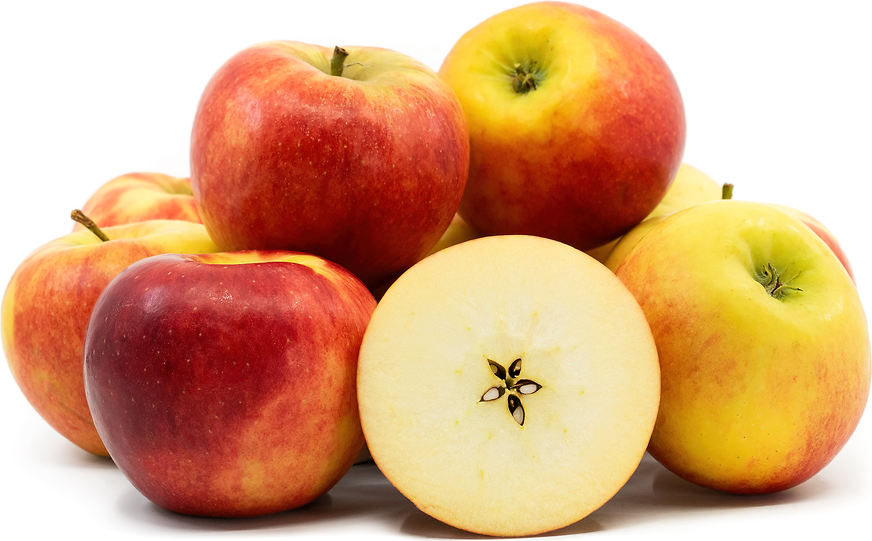


Elstar Apples
Estimated Inventory, lb : 0
Description/Taste
Elstar apples are small to moderately sized fruits, averaging 7 to 8 centimeters in diameter, and are round to conic in shape, sometimes exhibiting a slightly lopsided appearance, depending on growing conditions. The skin is bright yellow, covered in large patches of dark red to orange, marbled blush, and has a semi-chewy consistency with a subtly ribbed texture. Underneath the surface, the flesh is pale yellow to ivory, faintly aromatic, smooth, and crisp, encasing a central, fibrous core filled with small, black-brown seeds. Elstar apples have a balanced, sweet-tart flavor with pear and honey undertones mixed with mild acidity.
Seasons/Availability
Elstar apples are available in late fall to mid-winter.
Current Facts
Elstar apples, botanically classified as Malus domestica, are a popular, late-season European variety belonging to the Rosaceae family. The sweet-tart fruits were created as an improved cultivar of the golden delicious apple in the mid-20th century and were favored by growers for their cold tolerance, sharp flavor, and high yields. In the modern-day, Elstar apples are common to find in local European markets, commercially cultivated across continental Europe as a dessert cultivar. Outside of Europe, the variety is regarded as a specialty cultivar, primarily grown and sold through farmer’s markets and orchards.
Nutritional Value
Elstar apples are an excellent source of fiber to help stimulate digestion and are a good source of vitamin C, which is an antioxidant that can strengthen the immune system and increase collagen production within the skin. The apples also contain some vitamin K, potassium, manganese, vitamin B6, and riboflavin.
Applications
Elstar apples are best suited for raw applications as their sweet, subtly tart flavor is showcased when consumed fresh, out-of-hand. The apples can be sliced and tossed into green salads, quartered and served with cheeses, spreads, and dips, or chopped and added to grain bowls and fruit bowls. The apples can also be dried to extended use as a chewy snack. In addition to fresh applications, Elstar apples are utilized in baked goods such as pies, tarts, and strudel. They can also be pressed into cider, cooked down into sauces and compotes, or pureed into applesauce. Elstar apples pair well with spices such as nutmeg, allspice, cumin, cloves, and coriander, meats such as duck, poultry, and pork, aromatics such as ginger and garlic, and cheeses such as ricotta, cheddar, blue, and brie. Whole Elstar apples can be stored up to three months when kept in a cool, dry, and dark place. As the fruits are stored, the flesh will develop a sweeter taste.
Ethnic/Cultural Info
Apples are considered to be one of the most widespread fruits in Europe and have a unique history of being consumed by both royalty and commoners. The practice of pureeing apples into sauces dates back to medieval times and was a popular preservation method as it was quick and inexpensive to prepare. Many different apple varieties were used to impart sweet and tart flavors into applesauce, and over time, the tradition of pairing applesauce with roasted meats became a meal frequently eaten in the winter. Legend has it that pork became the favored meat to pair with applesauce because of its ability to be made into bacon, sausage, or ham. The preserved pork could be stored with applesauce for extended periods, and both items could create a balanced, sweet, savory, tart, and rich dish. In modern-day, applesauce is still beloved in the cuisine of many cultures, including the Dutch. The pureed mixture is known as appelmoes in the Netherlands and is widely used as baby food. Elstar apples are one of the most popular varieties used for appelmoes and is often seen as a side dish served with chicken and French fries.
Geography/History
Elstar apples were bred in 1955 by Dr. T. Visser at the Institute for Horticultural Plant Breeding, located in Wageningen, Netherlands. The variety was created from a cross between the golden delicious apple and the lesser-known ingrid marie apple, which was bred from the famous orange pippin. In 1965, the cultivar underwent extensive trialing and testing, and it was later released as a new variety, becoming one of the most popular apples in continental Europe. Elstar apples were later introduced to the United States and Canada in 1972. Today Elstar apples are widely available in fresh markets and grocers across Europe and are considered to be a specialty variety grown through select farms in the United States. The Elstar apples featured in the photograph above were grown through Windrose Farm, located in San Luis Obispo County, California.
Recipe Ideas
Recipes that include Elstar Apples. One
| Texanerin Baking |
|
Healthier Sauteed Apples |
| Nutmeg & Vinegar |
|
Traditional Dutch apple pie |
| Nutmeg & Vinegar |
|
Homemade applesauce recipe |

















